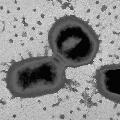



|
| This project is collaborated between The Forsyth Institute (TFI) and The Institute for Genomic Research (TIGR), and is funded by National Institute of Dental and Craniofacial Research (NIDCR) |
|
|
|||||||||||||||||||||||||
Association of P. gingivalis with Periondontal DiseasesClinical evidence connecting P. gingivalis with periodontal disease is presented in two recent reviews (McBride et al., 1993; Hafajee and Socransky, 1994). Elevated levels of the organism were found in periodontal lesions, and low levels in healthy sites (Spiegel et al., 1979; Zambon et al., 1981; Choi et al., 1990; Moore et al., 1991). The bacterium was eliminated by successful therapies (Hafajee et al., 1988; Ali et al., 1992), but was found in recurrent infections (Choi et al., 1990). Increased systemic and local immune responses to P. gingivalis were measured in subjects with various forms of the disease (Zambon et al., 1986; Mouton et al., 1987; Murray et al., 1989; Curtis et al., 1991; Duncan et al., 1992; Johnson et al., 1993; Ogawa et al., 1991). Furthermore, the organism produces numerous enzymes that have been shown to interact with and degrade host proteins in vitro and in vivo (described elsewhere ). Strains of P. gingivalis are also correlated with destructive periodontal disease in several other non-human species, either as naturally occurring or ligature-induced infections (Slots and Hausmann, 1979; Svanberg et al., 1982; Evans et al., 1992). In a Koch’s postulate-style study, Holt et al., (1988) were able to induce periodontal disease in rifampicin-treated monkeys by infection with a rifampicin-resistant strain of P. gingivalis. |
|||
|
This page is created and maintained by Drs. Margaret Duncan, Floyd Dewhirst, and Tsute Chen, Department of Molecular Genetics, The Forsyth Institute . Last modified on 02/20/2002 Copyright 2000, 2001, 2002 by The Forsyth Institute |